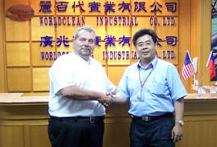
-----
Hardcoat Acid Concentration?
Q. I am interested in hardcoating several small aluminum components. The only thing I have not been able to find is the molar concentration of the sulfuric acid needed. Anybody got any background knowledge? I've seen references to % but none of these reference the molar concentration of the acid that makes up that %. Any help would be appreciated.
- Toledo, OH USA
A. Here are some info which may help you convert % concentration to molarity:
PERCENT SOLUTIONS
There are three types of percent solutions. All are parts of solute per 100 total parts of solution.
Based on the following definitions you may calculate the concentration of a solution or calculate how to make up a specific concentration.
1. % W/W -
Percent of weight of solute in the total weight of the solution. Percent here is the number of grams of solute in 100 grams of solution.
Example:
A 100% (W/W) H2S04 solution is made by weighing 100 g H2S04 and dissolving in 100 g of solution.
2. % W/V -
Percent of weight of solution in the total volume of solution. Percent here is the number of grams of solute in 100 mL of solution. This is probably the least significant way of naming a solution, but the most common way of doing it. In fact, any percent solution not stipulated as W/W, W/V, or V/V is assumed to be % W/V.
Example:
A 4% (W/V) H2S04 solution is 4 g of H2S04 in 100 mL of solution.
3. % V/V -
Percent of volume of solute in the total volume of solution %V/V. Percent here is the number of milliliters of solute in 100 mL of solution.
MOLAR CONCENTRATIONS FOR H2SO4:
1 MOLAR H2S04 = 98 g/L
- Toronto, Ont
A. One reference gives 180 to 225 grams per Liter. You can handle the math from there.
James Watts- Navarre, Florida
A. Chris,
There is a lot more to hardcoat anodizing than acid concentration. Amps, Volts and temperature are just as important. If you are serious about doing or having parts hard coat anodized to meet a specification, I suggest that you attend an AESF or AAC course or contact a consultant. To answer your question 180-200 grams per liter.

Drew Nosti, CEF
Anodize USA
Ladson, South Carolina

Sulfuric acid based electrolyte is used to obtain Decorative Anodizing (DA)(average anodizing thickness 20 µm) or Thick-layer Anodizing (hardcoat anodizing) (TA)(up to 100 µm). Normally temperature for DA process should not exceed 22° C, for TA temperature should not rise higher than 4° C. Cooling equipment is required in order to obtain quality DA coating in southern countries, and refrigerating equipment for TA add to the overall cost of the anodizing.
In order to avoid low processing temperature hard anodizing is performed in a tank filled with, not sulfuric, but oxalic acid (Japanese method) or mixed acid solution of sulfuric and oxalic acid with water (American method). Oxalic acid bathes are more expensive and significantly less stable in the industrial process.
adv.
Russamer Lab developed HEATAN additive, which raises DA limit temperature up to 35 °C, and TA limit temperature up to 22 °C.
By adding HEATAN additive we decrease amount of sulfuric acid in electrolyte and significantly raise the limit temperature for decorative, as well as hardcoat anodizing processes.
HEATAN is added during initial electrolyte preparation, and later during electrolyte correction 2 times a year.Basic electrolyte:
H2SO4 60 g/l
Al2(SO4)3 x 18H2O - 150 g/l
Decorative Anodizing:
HEATAN additive 1%
temperature up to 35° C
Current density 1.5 - 2.5 amps/dm2 (depending on the Al alloy type)
Thickness : 15 -20 µm
Thick-layer Anodizing:
HEATAN additive -10%
Process temperature: 15 - 22° C
Current density 1.5 - 2.5 A/dm2
Thickness up to 100 µm
Microhardness up to 500 Mpa
Please visit our site for more information.

Anna Berkovich
Russamer Lab - Pittsburgh, Pennsylvania
(ed. update July, 2025: sorry, Anna has retired)
A. Hi Chris. If you want to do only "several small aluminum components", you are probably a hobbyist rather than an employee of an industrial facility? In that case you probably will find it difficult or impossible to buy the electronic-grade concentrated sulfuric acid usually recommended, so you would have to buy 2 N (1 M) laboratory sulfuric acid [sulfuric acid on
Amazon, affil link]
, which would be slightly on the weak side, or battery acid
⇦ on
eBay
or
Amazon [affil link]
, which seems to run about 4.2 M, and would have to be diluted about 1:1 with de-mineralized water.
Luck & Regards,

Ted Mooney, P.E. RET
Striving to live Aloha
finishing.com - Pine Beach, New Jersey
Ted is available for instant help
or longer-term assistance.
Q, A, or Comment on THIS thread -or- Start a NEW Thread
